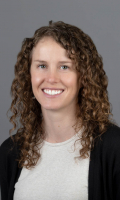
Dr. Penny Atkins - Director, Research and Science
Adjunct Assistant Professor - School of ComputingWEB 3853
phone 801-895-4957
supervisor Dr. Manish Parashar
Personal Home Page
Background
After completing my BS in Industrial Engineering (Montana State University, 2009), I worked at the Bechtel Marine Propulsion Corporation at the Idaho National Lab for four years before pursuing my PhD in Bioengineering (University of Utah, 2018). After defending, I accepted a post-doctoral fellowship in Switzerland (ETH Zurich). In late 2020, I returned to the University of Utah as a research associate within the SCI Institute and Department of Orthopaedics. With the launch of the One Utah Data Science Hub in 2022, I took on a research development role as the associate director and am now working to support the One Utah Responsible AI Initiative (One-U RAI) at SCI.
